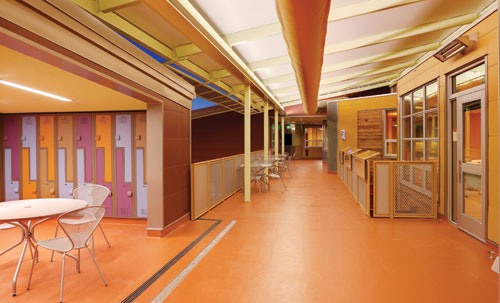Sustainable Rubber Flooring for Healthcare and Education
Technical requirements such as resilience, slip resistance and mobility, acoustics, indoor air quality, hygiene, and sustainability are essential in flooring. But it doesn't hurt—and research shows it very often helps—to make people happy, too.
 |
The recycled rubber flooring designed for the Redding School of the Arts, a charter school in northern California, reflects the school's philosophy that art enriches, expands, and prepares students for life. Photo by Whittaker Photography |
| Checklist: The Most Sustainable |
What are the characteristics of the most sustainable, state-of-the-art recycled rubber flooring products available? ■ High content (up to 70 percent) of cleaned and recycled post-consumer SBR from black scrap tire, blended with pigmented EPDM rubber (up to 20 percent recycled), granulated for additional color ■ Company produces its own line of EPDM for use in the form of color chips, using specially cleaned and post-consumer material from virgin EPDM manufacturing ■ High recycled content throughout the flooring product, not just in the base or wear material. Highest: solid recycled rubber flooring, or new products that fuse the wear layer with the underlayment to form a single-component product. ■ Manufactured with a low-heat processes that cause little or no off-gassing. ■ Extremely low levels of VOCs (at or approaching zero) throughout flooring’s life span, meeting FloorScore, Washington State, CHPS, and other stringent criteria ■ No chemical laminate or high heat vulcanization to define the wear surface ■ Ergonomic performance by established independent standards ■ Construction waste management programs ■ End-of-life “take back” programs ■ Manufacturer participates in ASTM e2129-05 Sustainability ■ Product meets criteria allowing contribution to USGBC LEED points |
Recycled Rubber Flooring and LEED
Recycled rubber flooring's high recycled content and low VOC emissions can help contribute points toward LEED certification, including LEED for Health. Your manufacturer should be able to give you detailed guidance. The following is a summary of some potential areas:
Materials and Resources
MR 2.1 & MR 2.2 Construction Waste Management:
Possible when recycled rubber flooring selvages and overages; can be shipped back to manufacturer for re-grinding into new products.









